Phoenix of Longadu
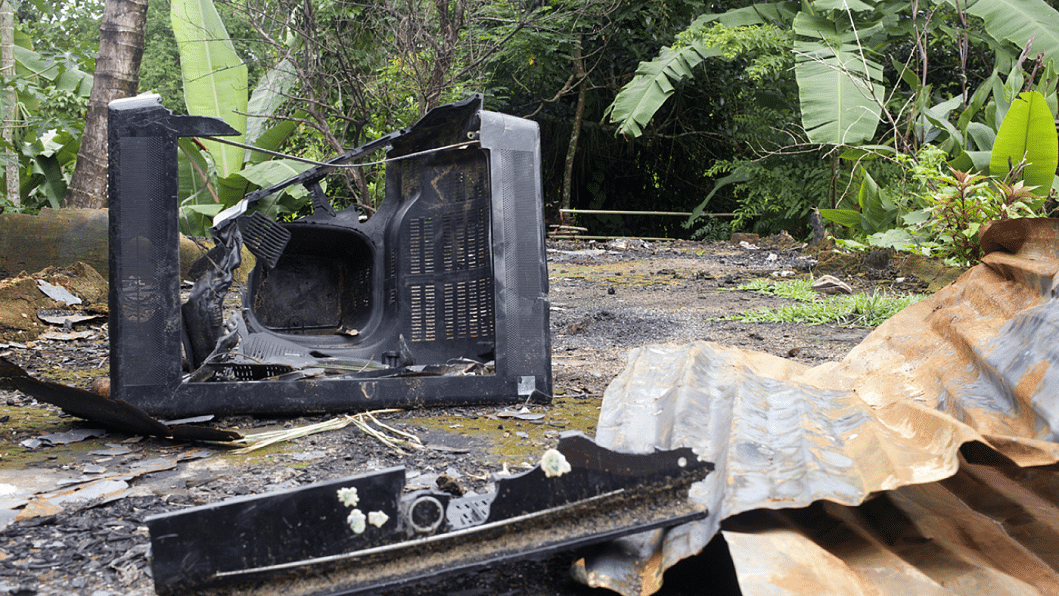
"Eto khabar pabi, shesh korte parbi na (You'll get so much food, you won't be able to finish it)." This was the promise that broke down the defences of the indigenous community at Longadu. In an act of defiance, they had initially refused government aid after the arson attack by Bengali settlers that left 224 houses ravaged, according to government figures. Their food stores burnt to a crisp, their children starving, they had no choice but to accept the 30 kg of rice, two blankets, bundle of tin, BDT 6,000 in cash, and the promise of more to come offered by the very authorities they felt betrayed by. But it was simply not to be. The last time they received aid was July 12. Ever since, not a grain of food has been sent to the families, still homeless, and now with nothing to eat.
"After the landslide, it became all too clear where the aid was headed. Of course there would be an inclination to send relief to the Bengalis," says Mrittika Kamal, Director of Terracotta Creatives and one of the curators of Phoenix of Longadu, a charity exhibition, held between October 16 and 19 at Drik Gallery, dedicated to raising funds for the affected families. "I saw children eating nothing but potatoes from the forest nearby, crying for food. Families that are slightly better-off will share half of their food with those that are worse-off," she recalls from her last visit to Longadu a couple of weeks back.
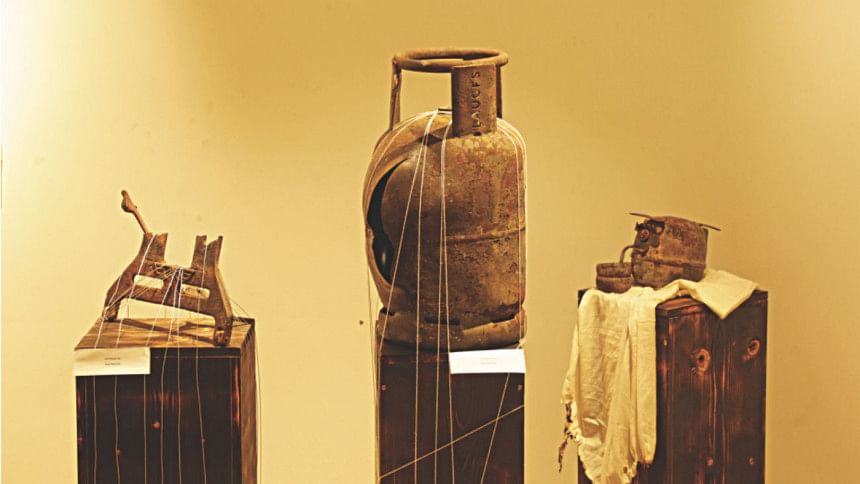
Primarily a documentary filmmaker, she rushed to the hills of Rangamati after all hell broke loose on Tintilla, Baittapara, and Manikjor Chhora villages on June 2. She'd been planning the exhibition ever since.
"But pictures and footage were simply not enough to open up the public's eyes to the horror and sheer extent of the destruction," Mrittika explains. She and her collaborators returned not only with film and photos, but pieces of the carnage, which constitute the seven installations on display at the gallery. A charred children's bicycle leans in an alcove on the third floor. Further inside sits a burnt sewing machine, perhaps once someone's only source of income. Against one wall is a bloated gas cylinder, blown-up in the heat of the fire. Nearby, the fine china, once the pride of a family, lies shattered. In the middle stands a burnt-tin fort with molehills of black soot and rubble atop it weighing it down. Upon closer inspection, one realises they are not heaps of crumbled cement, but of burnt grain. Together, they tell one devastating story: these people were left to die.

Along with the installations and 50 photographs taken by Mrittika, Uzan Rahman and Chisty Kanon, over a hundred prominent and amateur artists, as well as teachers and students from the University of Dhaka, Khulna University, Jahangirnagar University and Jagannath University contributed paintings to the fundraiser, while the indigenous community of Bangladesh set up stalls of traditional wares, clothes, foods, and fresh vegetables at the fundraiser. "Binni balls"—a sticky rice and coconut delicacy—and "pajon"—a spicy mixed vegetable curry—were a rare and unique treat for Bengali city-dwellers.
What drew more attention were the photographs that Mrittika, Uzan Rahman, and Chisty Kanon have captured. Before the exhibition, Mrittika had told me about how the amount of aid given to a particular family based on whether their house was "fully damaged" or "partially damaged". The government had identified around 87 houses as the latter. They were mainly the brick-and-mortar structures whose walls are still miraculously standing. One such "partially" damaged house is depicted in Kamal's photograph "Nothing to hope for". Its insides have been smoked out, its roof blown off. The walls, although standing, look like they've come under fire. In Chisty Kanon's "Under the open sky", the remains of a roofless red-brick house, akin to the ruins of a warzone, look like they could crumble any minute. In Kamal's "Burnt to ashes", "Evicted from their roots", "Destruction", "When all is lost", and "Destroyed", where once stood homes lie heaps of burnt tin. And in Kanon's "Untitled 2", all that survived the fire is a metal door bolt, lying on the scorched earth.
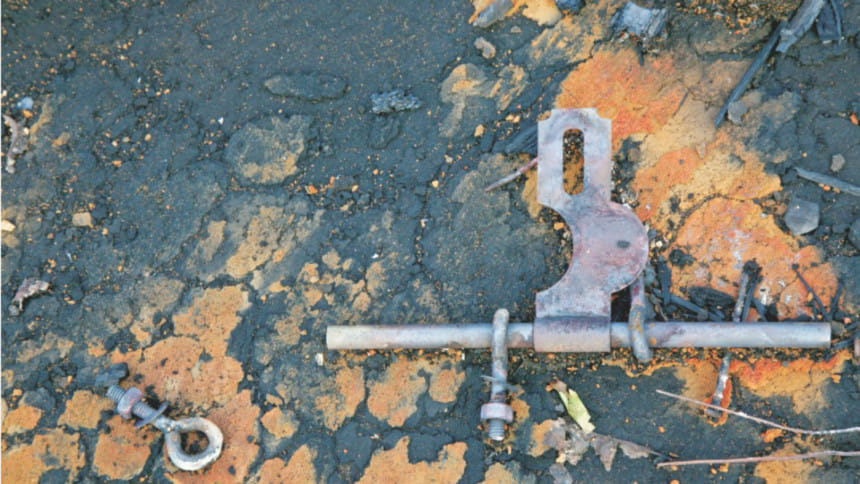
Families peer out of doors of crumpled-tin sheds. There's a hole in a newly laid roof, which won't last a storm. Amidst the debris in "Nowhere to cook" sits a charred vegetable grater, kettles, and plates. You might spot a stabiliser, but no fridge. If the pillagers couldn't lift the television, they burnt it. Not a single one of these houses is "partially damaged".
In a video playing on the second floor of Drik, a little girl in a frock tries to speak between chokes and sobs. It has taken her a lot of courage to say the things she has said—that they have nowhere to go, nothing to eat, no books, no food, no bed, and no hope. Because children do not dare return to their schools, which are situated in the Bengali community of the upazila. The indigenous families fear for their lives in those parts.
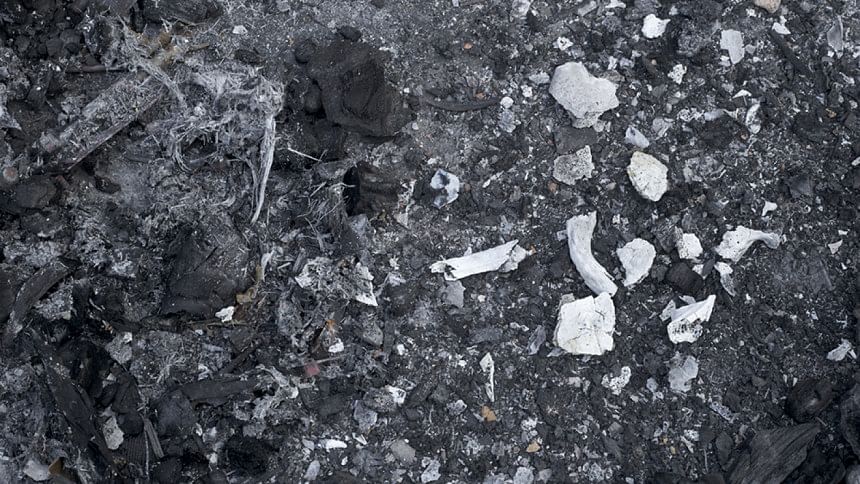
"One man told me, 'Je majhir noukay shara jibon uthechi, shei noukay ekhon pa dite bhoy pai' (The fisherman whose boat I took all my life, I now fear to set foot in," shares Mrittika. Those who worked as labourers in the city do not dare return. The Bengali shop they've gone to all their lives, they no longer enter. Of course they have no shops of their own to go to. The attackers made sure to take out the furniture from the Bengali-owned shops before setting fire to the Adivasi-owned ones.
In fact, this wasn't even the first time Bengali settlers had launched an attack on them. The riot of 1989 claimed 35 indigenous lives in Longadu. The attack in June disrupted their decades-long efforts to rebuild their lives and renew their trust in their neighbours. They've become Bengali-phobic.
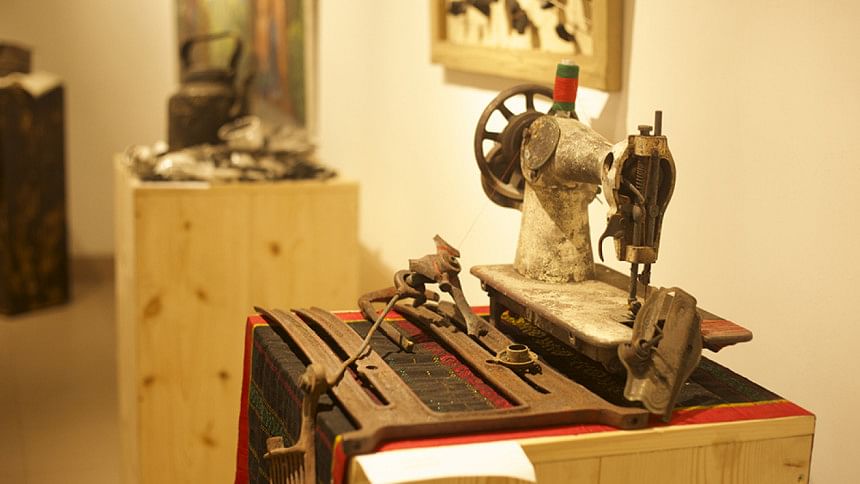
And why wouldn't they after these same Bengalis slaughtered, then burned their own? Mrittika's "Still burning" depicts a fistful of ashen bones—the charred remains of septuagenarian Gunamala Chakma. The deaf and near-crippled woman sought refuge in the Chairman's house in Tintilla. Kulin Mitra Chakma, Upazila Chairman of Longadu, says some of her last words, spoken to the attackers, were, "Why are you hurting me? What did I do to you?" Kulin had hid near a date tree and was helpless when they assaulted her. They stowed away the body, set fire to the house, and made away with BDT 7 lakh in government funds.
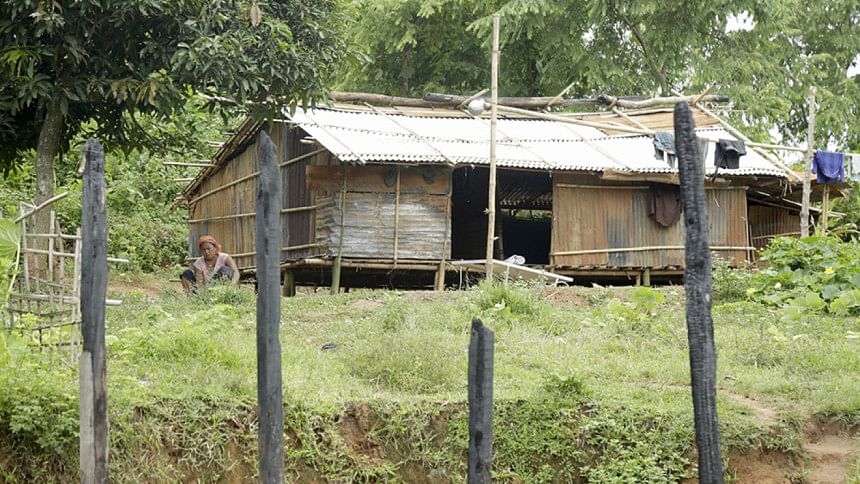
With no resources, no relief, and no rights, the families of Longadu now reside out of kitchens, in cow sheds, or Buddhist temples nearby. The proud brick houses, humble mud huts, and tin cabins all lie in ruin. In the midst of this chaos, books were distributed amongst the children, but they were given no notebooks to write in, no pens to write with. Mrittika informs that the funds from the sale will be focused towards educational materials for the children. But of course, this is far from enough.
In the spirit of renewal and solidarity, the government and the public must come together to help rebuild the lives and livelihoods of the people Longadu. Above all else, we must stand beside them, assure them they will not suffer the same fate a third time.
Photographs and paintings from Phoenix of Longadu will be available for sale at: terracottacreatives.com. Sales profits will be used to provide educational materials to the children of Longadu.

 For all latest news, follow The Daily Star's Google News channel.
For all latest news, follow The Daily Star's Google News channel. 


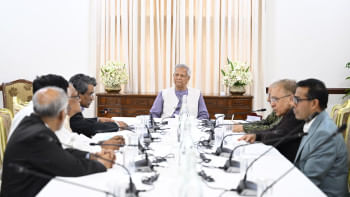
Comments